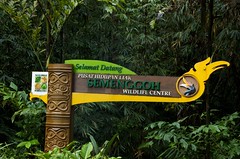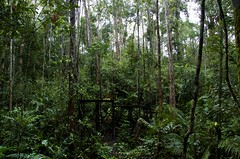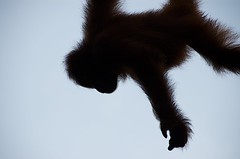 The Semenggoh Wildlife Centre was originally established to rehabilitate animals and birds who had been held in captivity by humans. Often, these animals were kept as pets by the local population, and later confiscated by Sarawak Forestry. Many of the animals at this centre were successfully prepared for life back in the wild, and subsequently released. This original mission of rehabilitation has since been moved to the nearby Matang Wildlife Centre. In present times, Semenggoh hosts a group of 24 Orang Utans (the Borneo species; Pongo pygmaeus), who inhabit an area of 650 hectares of primary rainforest.
The Semenggoh Wildlife Centre was originally established to rehabilitate animals and birds who had been held in captivity by humans. Often, these animals were kept as pets by the local population, and later confiscated by Sarawak Forestry. Many of the animals at this centre were successfully prepared for life back in the wild, and subsequently released. This original mission of rehabilitation has since been moved to the nearby Matang Wildlife Centre. In present times, Semenggoh hosts a group of 24 Orang Utans (the Borneo species; Pongo pygmaeus), who inhabit an area of 650 hectares of primary rainforest.Map of Semenggoh Wildlife Centre
View Larger Map
 The Orang Utans of Semenggoh are semi-wild. They were introduced into the reserve after their rescue from humans. Since that time, several of the female Orang Utans have given birth within Semenggoh itself. Due to its relatively small size, the reserve is unable naturally to support the number of Orang Utans who live there, and so they are fed twice each day from wooden platforms. These feeding times present an opportunity for visitors to see the primates first hand.
The Orang Utans of Semenggoh are semi-wild. They were introduced into the reserve after their rescue from humans. Since that time, several of the female Orang Utans have given birth within Semenggoh itself. Due to its relatively small size, the reserve is unable naturally to support the number of Orang Utans who live there, and so they are fed twice each day from wooden platforms. These feeding times present an opportunity for visitors to see the primates first hand. During feeding times, the keepers of the reserve call the Orang Utans, and they descend to their food platforms by brachiation along a suspended network of ropes and cables. At a morning feeding, we initially saw several young Orang Utans, and were warned to stay well clear of them because they are known to throw things at human visitors. The young Orang Utans tended to stuff as much food as possible into their mouths before retreating higher into the trees to eat. Later, we saw the dominant male Orang Utan, called Ritchie, who appeared to be more relaxed, and remained on the feeding platform to eat some bananas.
During feeding times, the keepers of the reserve call the Orang Utans, and they descend to their food platforms by brachiation along a suspended network of ropes and cables. At a morning feeding, we initially saw several young Orang Utans, and were warned to stay well clear of them because they are known to throw things at human visitors. The young Orang Utans tended to stuff as much food as possible into their mouths before retreating higher into the trees to eat. Later, we saw the dominant male Orang Utan, called Ritchie, who appeared to be more relaxed, and remained on the feeding platform to eat some bananas.

 After the feeding time, we paid to go on a hike around Semenggoh with one of the Orang Utan keepers, called Dominick. Dominick led us on a trail which passed cages that were previously used to quarantine birds, Orang Utans and gibbons, after their rescue from humans. It was also on this trail that we saw our first pitcher plants in Borneo. As usual, I sweated a lot in the high tropical humidity, and was quickly soaking from head to toe. It was a fantastic experience, and the only down-side (if it can be called one) was being attacked by tremendously voracious leeches. The leeches found their way throughout my shoes and socks, but I was able to remove most of them safely (safe for both myself and the leeches). The only leech to leave a mark was one that attached itself to the inside of my right upper arm. Trying to remove this one was a mistake, since it had already started feeding. The anti-coagulant it had released left the wound bleeding for a couple of hours, and produced a red circular mark which is still visible 3 days later!
After the feeding time, we paid to go on a hike around Semenggoh with one of the Orang Utan keepers, called Dominick. Dominick led us on a trail which passed cages that were previously used to quarantine birds, Orang Utans and gibbons, after their rescue from humans. It was also on this trail that we saw our first pitcher plants in Borneo. As usual, I sweated a lot in the high tropical humidity, and was quickly soaking from head to toe. It was a fantastic experience, and the only down-side (if it can be called one) was being attacked by tremendously voracious leeches. The leeches found their way throughout my shoes and socks, but I was able to remove most of them safely (safe for both myself and the leeches). The only leech to leave a mark was one that attached itself to the inside of my right upper arm. Trying to remove this one was a mistake, since it had already started feeding. The anti-coagulant it had released left the wound bleeding for a couple of hours, and produced a red circular mark which is still visible 3 days later!Orang Utans and humans share a long period of post-natal maternal care. Orang Utan mothers take care of their young for a period of around 4 to 5 years after birth, and will only reproduce again when their offspring are independent. Naturally, Orang Utans are semi-solitary animals, and the crowded state of the Semenggoh reserve is only maintained through human assistance. Even with regular feeding times, the 650 hectares of the reserve is only enough room for a single dominant male; currently Ritchie. I wondered how genetic diversity will be maintained in the successfully-breeding captive population, but haven’t yet found out what plans are in place to achieve this. The only mention made of transporting Orang Utans was that Sarawak Forestry supplies them to the zoos in Western Malaysia.
Overall, Semenggoh Wildlife Centre was a great place to visit. We were lucky in seeing so many Orang Utans at the feeding platform. Several guide books mention that sightings are not guaranteed, and that it is worth setting aside a whole day in order to see both morning and afternoon feeding times. The keepers told us that the Orang Utans were more likely to attend feedings when the local plants were not fruiting, so it would be worth checking when this period occurs.
Don’t forget that more pictures of my journey are available online at my Flickr Photostream: http://www.flickr.com/photos/28808691@N05/

No comments:
Post a Comment